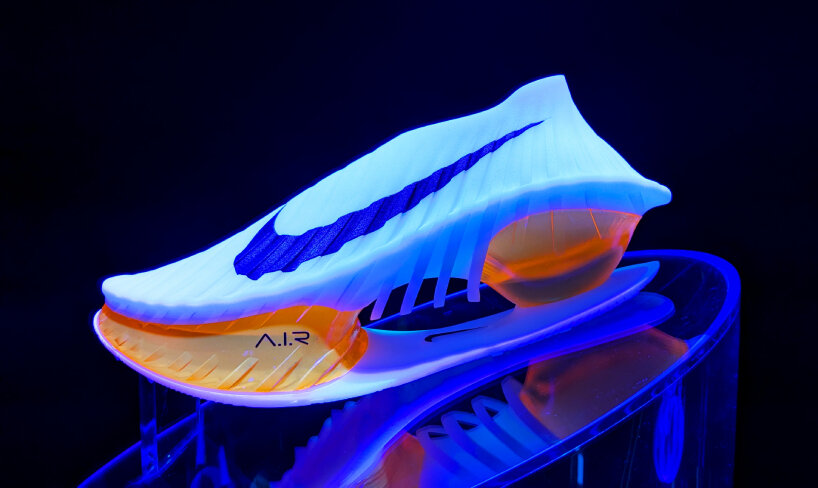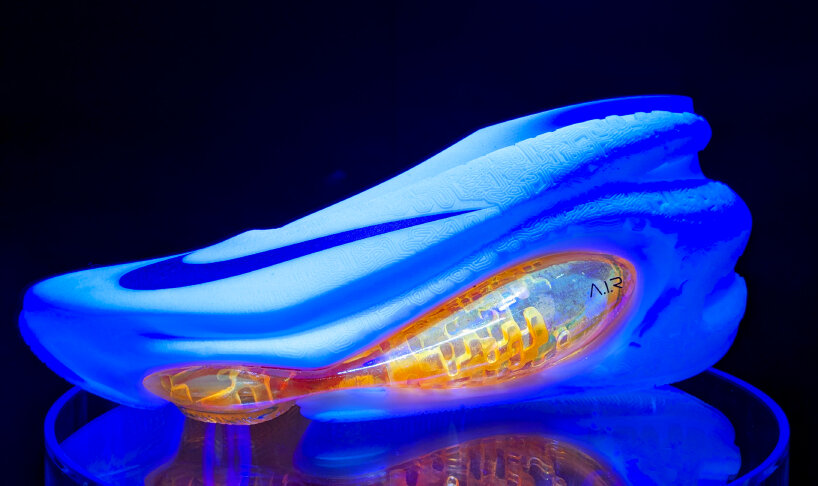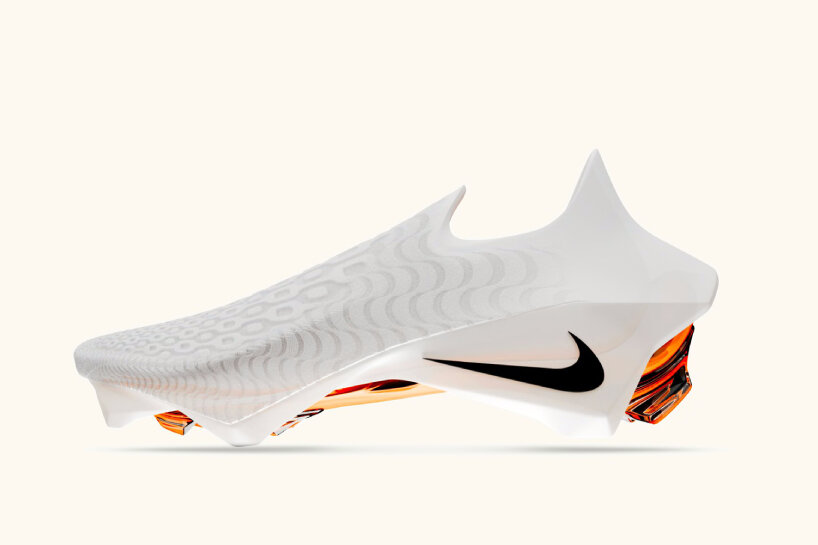NIKE presents 3D-printed AI sneakers, A.I.R
Form and function meet fantasy as NIKE debuts A.I.R, a new collection of 13 concept sneakers made and designed with man-made sketches, computational and parametric design, generative AI, rapid prototyping, and 3D printers. In the exhibition and runway show designboom attended inside Palais Brongniart in Paris, NIKE introduced A.I.R, which is short for Athlete Imagined Revolution. John Hoke, NIKE’s Chief Innovation Officer, tells designboom in an interview that NIKE’s new series of 3D-printed AI concept sneakers looks into the future of its footwear design. ‘We call this project A.I.R. The goal of the project was to think beyond today, beyond Paris 2024. We’re studying and working directly with athletes. These are not just performance shoes; they’re blending performance with persona. This is what I’ll call the new alchemy of shoes,’ he shares with designboom.

Faith Kipyegon | image © designboom
It was 7:30pm, and inside Palais Brongniart, an expansive LED screen flashed the detailed views of the 13 NIKE A.I.R 3D-printed and AI-designed sneakers. Serena William was narrating the future of the shoe company’s footwear, and soon, the screen rolled up slowly to show the 13 athletes who NIKE worked with and dedicated the AI sneakers to, spanning across four sports: track, global football, basketball, and tennis. When the screen was lowered and brought back up again, the 13 prototypes of A.I.R sneakers came to view, blazing in their semi-translucent and hardened 3D-printed material, glowing under the seemingly UV light, making the hot-orange colorway burn brighter like fired glass.

Kylian Mbappé | image © designboom
AI and 3D-printers with man-made designs for A.I.R
John Hoke explains to designboom that the NIKE A.I.R design team began using AI as a part of their mood boards, a generator of inspirational images that can allow them to visualize the futuristic 3D-printed concept sneakers. ‘We began to create prompts together with large language models that conjured quick images. And because of the pace and the fidelity of those images, we were quickly able to move from a series of a hundred plus mood boards into a design. And then the design process moved from strictly 2D into something we call phygital design, both physical and digital,’ he shares with designboom. From here, their computational designers picked up the pace and used mathematical algorithms and 3D design programs to take these 2D images, feed them into 3D printers and churn out the prototypes in just hours, maximum of a few days.

Zheng Qinwen | image © designboom
John Hoke and NIKE A.I.R’s design team worked with the 13 athletes along the way. They met up and sat down with Sha’Carri Richardson, Victor Wembanyama, A’ja Wilson, Kylian Mbappé, Dina Asher-Smith, Rai Benjamin, Diede de Groot, Erling Haaland, Sam Kerr, Eliud Kipchoge, Faith Kipyegon, Zheng Qinwen, and Vinicius Jr. They asked them questions about whether they liked their AI-designed sneakers to be conservative or wild, a holistic design or something defined by an individual component, monolithic or fractal. They interviewed them about the people, places and things that inspired them and how the concept sneakers could show who they are as athletes.

Eliud Kipchoge | image © designboom
The athletes’ answers were entered through detailed AI command prompts, and the software generated hundreds of visuals for each athlete. They were brought back to the athletes who gave NIKE A.I.R design team their feedback, and off the design team went to free themselves from any AI engines and back to manual creative sketching for the technical specs of the concept sneakers. These manual sketches swung back and forth between the athletes and the designers, the former adding and making notes and the latter finding ways to make the 3D-printed A.I.R sneakers as athlete resonating as possible. Once the designs were settled, they were run through rapid 3D printers at NIKE’s Concept Creation Center and then through the Air MI machines, located a mile away from NIKE’s headquarters in Oregon, producing the hard-shelled prototypes of the AI concept sneakers shown in Paris on April 11th, 2024.

Rai Benjamin | image © designboom
Exploring the 13 NIKE A.I.R 3d-printed AI sneakers
Back at Palais Brongniart, designboom got to see the 13 NIKE A.I.R 3D-printed AI concept sneakers, with John Hoke showing us around after the preview. Before the recorder played, he had picked up Zheng Qinwen’s footwear. A thick, jelly-like orange tube loops around the 3D-printed sneaker before the upper rear peaks with a pointed crest. John Hoke flipped it to expose what was underneath, a series of engraved scales that poked out of the shoe, hard to touch yet soft to graze the fingers on at the same time. The serpentine and scaly construction was inspired by the Chinese lunar calendar’s Year of the Dragon, the brief that Zheng Qinwen imagined for her NIKE A.I.R sneaker, one that came to life with the help of AI and 3D printers.

Victor Wembanyama | image © designboom
John Hoke walked a few steps further, still on stage inside Palais where NIKE introduced project A.I.R, towards Victor Wembanyama’s 3D-printed AI sneaker sized for his 21-inch foot. ‘Victor is fascinated with science fiction and alien technology,’ John Hoke tells designboom. ‘You can see some of the details in the light, some of the texturing and pattern that conjures this futuristic alien vernacular. In this case, we took the Zoom Airbag under the foot, which gives him that pop and lift off the court, but also wrapped it around as a cradle to help lock him into this platform. He’s obviously got a large foot, so it’s a way that we, again, think about designing with these new technologies and let us create both velocity and fidelity design work.’ The hot-orange underfooting brightened as John Hoke put it back on the stand, pointing out the the bismuth crystal Wembanyama wore around his neck as the design inspiration, the one he had on draft night a summer ago when he was picked number one in the league.

A’ja Wilson | image © designboom
Faith Kipyegon’s NIKE A.I.R sneaker had a raw crystal feel to it. Surrounding the lower part of her 3D-printed prototype, the semi-transparent, geometric orange lining seemed to hide and show the NIKE’s Air cushioning at once. ‘Faith loves to train in our trail product, so when you look at this product, you can see this influence of a trail running shoe. You also see this exaggeration of fragmentation, of what a future trail shoe can be. If you look closely, you can see the bead work. She talked a lot about the bead culture and how that meant for her connection to the community. What I love on the back is we have this little swoosh that’s cradled inside of another swoosh, and that represents her child. All these little Easter eggs are found throughout these (3D-printed, AI-designed) products. It’s a way of having it be both a performance piece and a big part of their personality,’ John Hoke shares with designboom.

Vinicius Jr. | image © designboom
The other 3D-printed AI concept sneakers continued the flair of the orange and milky white colorways, all the while embodying the persona of the athlete they were tailored for. They were NIKE A.I.R sneakers designed by athletes, for athletes at the moment, to transpire in the future as everyday wear for everyone. Wearers may feel what it feels like to fit in Dina Asher-Smith’s sport-mesh upper and TPU heel clip, modeled after an elegant slingback; Rai Benjamin’s spiky outsole for cycling, bridged by a ribbed, hurdle-inspired midfoot plate; and Diede de Groot’s honeycomb-like upper with clipping mechanism for easy fastening to wheelchairs, with its heel tailgate taking inspiration from Flyease technology. Football fans may soon be able to put on Erling Haaland’s curved sneaker with the underfooting resembling Antarctic glaciers, and Sam Kerr’s design featuring a big, bold, and exposed heel and forefoot for when soccer players want to backflip after a joyous match.

Dina Asher-Smith | image © designboom
Marathoners might be able to step in Eliud Kipchoge’s 3D-printed AI sneaker, added a visible forefoot Air, detailed with sap-like tensile fibers, and strengthened by its beveled heel inspired by his insights into helping develop the historic Alphafly line. Kylian Mbappé’s spiky underfooting and a design that recalls winged sandals of the Greek messenger god Hermes, Sha’Carri Richardson’s raised heel and a double-helix pattern wrapping up the shin, Vinicius Jr.’s boot with studs slanted outward for quick turns and cuts when dribbling, and A’ja Wilson’s slits on the upper and grilles on the side. These sneakers – part AI generated, part human created – think about and put NIKE in a future-forward design mindset for its Air series. ‘It’s this intimacy of not just asking the athlete to wear what we make,’ John Hoke shares with designboom. ‘It’s about working with us, co-creating, co-conspiring so that these products become as unique to them (athletes) as their fingerprint.’

Sam Kerr | image © designboom

Sha’Carri Richardson | image © designboom

Erling Haaland | image © designboom

Diede de Groot | image © designboom













project info:
name: NIKE A.I.R
company: NIKE






















